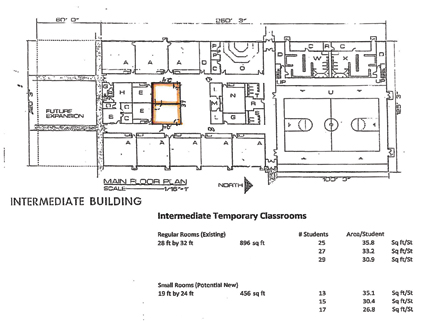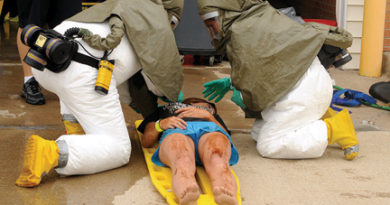Thayer Central Presents Request for Proposals at Public Facilities Meeting
On the evening of Feb. 12, the Thayer Central school board held a public meeting regarding the upcoming addition and renovations of the school.
Thayer Central plans to temporarily convert part of the intermediate building library into two temporary classrooms.
At the beginning of the year there were 27 in the fourth grade class which is split in two groups. In the fifth grade class, there were 26 students in one classroom. In the sixth grade class there were 25 students also in one classroom.
Since then, four kids have moved into the fifth grade class totaling the class at 30 students.
“Next year going into sixth grade, we need to split [that class]. People come to communities like Thayer Central to get away from huge class sizes,” said Drew Harris, Thayer Central superintendent. “We are in need of ten classrooms in the intermediate building to accommodate that. There are eight classrooms there right now so we are two classrooms short.”
The classrooms will have a total width together of 39 feet. In other words, the space will be about 19’ by 24’ giving students about 450 square feet and 30 square feet per child. Regular classrooms are about 900 square feet but hold around 29 students. By placing a split grade level in these new classrooms, the 15 or so students will have about the same amount of room as a regular classroom.
As for the intermediate library, the school plans to keep the reading pit where students can sit and read. The existing computer lab will be relocated to the business lab in the high school. Ultimately, however, Harris stated that “the key is that we want this to go back to being an extended library at some point.”
Though there is no set cost as of yet, Harris estimated at the meeting that they hoped to get the walls in the low $20,000 range. Including HVAC work and lighting, Harris said they hoped for the cost of the project to be under $30,000.
Once a permanent solution has been reached, Harris suggested that the modular walls could even be taken down and be reused.
“This is not an ideal solution but we felt it was the best option we had,” said Harris. “I think it’s essential that we agree that this is a short term solution. I don’t think its fair to take that whole area away from that building for the long term. Sometimes it’s easy to take a solution like that and say ‘oh it’s good enough’ but I think that would be really shorting our kids to do that for more than two to three years. I think that would allow us to get to a point where we could at least do a classroom addition that would suffice and take care of our space issue with the two classrooms.”
Leading that discussion for more permanent solutions were Thad Mumm and Scott Harms, volunteer members from the community serving on the facilities sub-committee.
The committee created a Request for Proposal (RFP) outlining the school’s background, project scope and facility improvement priorities. At the end of the RFP were a list of questions for designers to consider.
“The biggest thing we wanted to do on this was create an open book, start from scratch, find something that will really work and has a high probability for great community support and community buy-in and addressing the biggest things that the school needs,” said Harms. “The intent of this document is not to just get one idea back. We’d like to submit this to architect engineer combinations that work with contractors themselves. Basically they can help create their vision and propose it to us at which point we can get together as a community and try to figure out what best fits the school’s needs, what best fits the budget and what best fits what the community would like to see.”
To come up with the best suited design, the school district would like to submit this proposal to about eight different engineering design/construction management firms. From there, the companies would use the list of prioritized needs given in the RFP and submit a partial plan for a bid.
The sub-committee intentionally made the proposal without stringent guidelines followed by thought provoking questions at the end to inspire creativity from bidders.
“In traditional construction projects, you hire an engineer architect. They design one way to do it, then you bid it out for construction,” said Mumm. “The challenge here is we don’t know what we want. We don’t know how to do it best and we don’t know what we can afford. Those are huge factors in this project. We need the best options possible from outside the box. What we’re trying to do is go to a different way to bid the project. We are going to multiple engineer architects and having them compete to give us the best options and ideas that will fit our needs in an economical way.”
“What that does is really leverage the creativity they have themselves,” said Harms. “Other school districts have done this successfully. We feel we can do that as well.”
During the meeting, Harms and Mumm laid out the RFP and discussed the proposal with the public, emphasizing that community approval and input was vital to the committees goals. Though at this point no concrete plans have been made
“We’d like to see a vision that can be done over the next several years,” said Harms. “We don’t know how it’s going to be done at this time, strictly because we don’t know what we can afford and we don’t know what it’s going to cost.”
Questions from the public:
Are we going to have to pay for the engineers to create the initial plans?
Mumm: No. Companies will spend a certain amount of money based on their expertise to win bidding jobs. And they don’t win them all. We didn’t want to spend money on something we didn’t think we’d be able to afford. We were trying to come up with a philosophy where we got as much free expertise as we could. They’re not going do 90 percent designs in this bid. Typically they’ll design around 40 percent, but they give you a concept and construction plan and cost.
Harms: You won’t have prints that you can quote. You won’t have a fully engineered design. But you would have a guarantee that you could build that vision for a given price. That’s what these companies do … [there’s] different methodologies as how things go about. There are pros and cons to each one but this is one of the popular ones that is done. We are not the only ones that are doing this.
What’s this going to cost?
Harms: [That’s] one of the first questions people ask: what’s this going to cost? That’s not the stage we’re at right now. We don’t know what its going to cost. That is a very important component of this. This is nothing more than a framework.
What construction process have we used previously?
Harris: Design, bid, build is the process we’ve used in the past where you design it first then potentially take it out to bid. That was the traditional method. It used to be the only way to do it. Since then, construction management has become very popular in the last one or two decades. Depending on how we proceed, the method we will use will either be construction management or design/build … There’s pros and cons to both. The construction management process is the more common way that things are done.
Thad: Design/build means that we bid it out to an engineer for a design to get estimates back and they’re partnering with a construction company and we’re going to award one contract where they are going to finish the design and construct it. Construction management means that we just award the engineering part of that and they will oversee the bidding of the construction later and be our liaison. The difference is in construction management you have a engineer/arch construction management team that is hired by the district and is a liaison and oversees construction, where the design/build you are more involved as a district overseeing and getting everything in place and it is awarded to a team of experts that meets your minimum specification on construction and engineering.
As of yet, the committee has not submitted the proposal to any designers.
“Our goal tonight was to see if we had support,” said Curt Mumm, the school board president. “Then in our next meeting we would be setting up a time frame, finishing this up, then start setting dates and have more public meetings.”
“We’re not going to lock into anything without giving the community a chance to look at it,” said Harms.
Facility Improvement Priorities
Critical Priorities
• Instructional/Learning Areas
– 8-10 areas needed on whether or not we vacate the primary
– To plan for potential growth, classroom size should accommodate up to 25 students per classroom
– These should adjoin to the intermediate building
• Improve Tornado Safety
– High school building
– The current areas are the locker rooms and main lobby restrooms
– Add/improve areas to accommodate student density
– Intermediate building
– The current areas are the locker rooms
– Add/improve areas to accommodate student density
– Primary building (should we continue to use it?)
– The current areas are the restrooms
– Add/improve areas based upon future usage
• Other Needs
– High school building
– Remodel locker rooms
– Gym east wall moisture issues
-Intermediate building
– Additional indoor play area
-Designed to accommodate at least 50 students
– Primary building (should we continue to use it?)
– Bathroom renovation
– Remove existing portable
– HVAC improvements
High Priorities (non-building specific)
• New band and vocal classroom(s)
– A new band room would open up space to increase our industrial arts department
– A new vocal room would open up space in the intermediate building for a special education classroom
• Building connectivity
• Parking expansion
Medium Priorities
• New competition gym
– A goal of the district is to add a new competition gymnasium
– This facility should include four locker rooms, a foyer (or
lobby) with restrooms
and a concession
area
– Consideration for a
weight room or
wrestling room
should be given either at this location or another one
– There have been discussions with our local hospital to build complementary areas
which could be used for
wellness-based activities.
These could be used by
the community for fitness
or related activities.
• Cafeteria remodel
– The kitchen has had
updates over the last few
years but the overall space
could use modernization.
Also, additional commons area for increased seating at one time may be helpful
• Roof at primary (if facilities are retained)
Questions and Factors for Designers to Consider
• Could the two room addition to the current eight classrooms in the intermediate building be done in a single phase to stay within our budget constraints? If not, can it cost-effectively be broken into two phases?
• Would it be more cost effective to abandon the primary building by constructing two additional classrooms, play space and associated facilities at the main campus for those students or remodel the existing primary building to house preschool students only?
• Could a new music room be incorporated into the project in a way to allow us to remodel the existing vocal room and reduce the number of new elementary classrooms needed by one?
• Could the additions proposed be designed in a way to provide building connectivity between the high school and intermediate building? This has been a past goal to increase safety and security, plus to avoid weather conditions when transferring between buildings.
• Could school parking improvements be made on the SW corner of the high school to improve existing structural issues with the current retaining wall?
• Our current gym is in need of either renovation or replacement. Do any options exist to cost-effectively re-utilize this space for classrooms, etc.? Considerations would need to include the ability to maintain a stage, whether fixed or portable, to allow for fine arts performances within this area.



